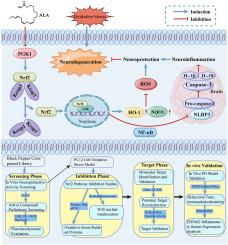Neuroprotective alpha-linolenic acid derived from black pepper targets PGK1 and activates the Nrf2 pathway in PC12 cells and mice
IF 4.7
3区 医学
Q1 PHARMACOLOGY & PHARMACY
引用次数: 0
Abstract
Background
Oxidative stress is a significant contributor to neurodegenerative diseases such as Alzheimer's disease and Parkinson's disease. Nuclear factor E2-related factor 2 (Nrf2), a pivotal regulator of antioxidant responses, is an emerging therapeutic target for these conditions. Our study assessed the neuroprotective effects of monomeric compounds derived from black pepper against hydrogen peroxide (H2O2)-induced damage in neuron-like PC12 cells. Alpha-linolenic acid (ALA) demonstrated superior protective effects.
Purpose
The aim of this study was to investigate the mechanism underlying the neuroprotective activity of ALA derived from black pepper.
Methods
H2O2 induces oxidative stress in vitro, and MPTP induces Parkinson's syndrome in vivo. Proliferation and apoptosis assays, fluorescent dye staining, Western blotting, real-time PCR, immunofluorescence, luciferase reporter assays, behavioural experiments, and immunohistochemistry were performed to investigate the effects of ALA and the underlying mechanism in vitro and in vivo.
Results
Our findings indicate that the ROS-scavenging and cytoprotective properties of ALA are likely mediated through Nrf2 activation and the upregulation of phase II antioxidant enzymes, including HO-1 and NQO1. Drug affinity responsive target stability (DARTS) assays revealed that ALA interacts with the PGK1 protein, potentially inhibiting its activity to promote Nrf2 activation. In vivo, the oral administration of ALA (60 and 120 mg/kg) significantly mitigated the behavioural deficits associated with Parkinson's disease, preserved dopaminergic neurons in an MPTP-induced mouse model of PD, and relieved nerve inflammation.
Conclusion
Our data suggest that ALA may be a candidate neuroprotective agent for the treatment of neurodegenerative diseases, offering novel insights and potential therapeutic targets for future interventions.

来自黑胡椒的神经保护α -亚麻酸在PC12细胞和小鼠中靶向PGK1并激活Nrf2通路。
背景:氧化应激是阿尔茨海默病和帕金森病等神经退行性疾病的重要诱因。核因子e2相关因子2 (Nrf2)是抗氧化反应的关键调节因子,是这些疾病的新兴治疗靶点。本研究评估了从黑胡椒中提取的单体化合物对过氧化氢(H2O2)诱导的神经元样PC12细胞损伤的神经保护作用。α -亚麻酸(ALA)显示出优越的保护作用。目的:探讨黑胡椒ALA的神经保护作用机制。方法:H2O2诱导体外氧化应激,MPTP诱导体内帕金森综合征。通过增殖和凋亡实验、荧光染料染色、Western blotting、实时荧光定量PCR、免疫荧光、荧光素酶报告基因检测、行为实验和免疫组织化学等方法研究ALA在体外和体内的作用及其机制。结果:我们的研究结果表明,ALA清除ros和细胞保护特性可能是通过激活Nrf2和上调II期抗氧化酶(包括HO-1和NQO1)介导的。药物亲和反应靶稳定性(DARTS)分析显示,ALA与PGK1蛋白相互作用,可能抑制其活性,促进Nrf2的激活。在体内,口服ALA(60和120 mg/kg)可显著减轻与帕金森病相关的行为缺陷,在mptp诱导的PD小鼠模型中保存多巴胺能神经元,并缓解神经炎症。结论:我们的数据表明,ALA可能是治疗神经退行性疾病的候选神经保护剂,为未来的干预提供了新的见解和潜在的治疗靶点。
本文章由计算机程序翻译,如有差异,请以英文原文为准。
求助全文
约1分钟内获得全文
求助全文
来源期刊
CiteScore
9.00
自引率
0.00%
发文量
572
审稿时长
34 days
期刊介绍:
The European Journal of Pharmacology publishes research papers covering all aspects of experimental pharmacology with focus on the mechanism of action of structurally identified compounds affecting biological systems.
The scope includes:
Behavioural pharmacology
Neuropharmacology and analgesia
Cardiovascular pharmacology
Pulmonary, gastrointestinal and urogenital pharmacology
Endocrine pharmacology
Immunopharmacology and inflammation
Molecular and cellular pharmacology
Regenerative pharmacology
Biologicals and biotherapeutics
Translational pharmacology
Nutriceutical pharmacology.

 求助内容:
求助内容: 应助结果提醒方式:
应助结果提醒方式:


